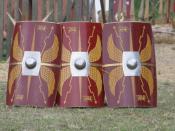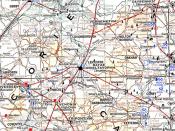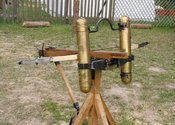Veni, vidi, vici. I came, I saw, I conquered, a quote ushered forth by the late Julius Caesar, long time dictator of Rome. The Roman Legion, the ultimate military machine of the ancient world, was the catalyst that spread Roman conquest and civilization throughout the known world. Nowhere else did the Roman talent for organization and assimilation show itself so clearly as in its army. The Romans had plans for everything, from arranging sieges to killing pachyderms. Their army was well equipped, their soldiers highly trained and their generals extremely experienced. No wonder their empire was so vast and stretched from Persia in the east, to Spain in the west.
The Roman military was a highly organized institution. There was a clear-cut system of rank, and there was a number of different divisions of the basic unit, the legion. There were about 30 legions. The legions were numbered, but the numbers tended to repeat themselves.
Each legion had about 5,500 men (Webster). The legion was subdivided into ten units called cohorts. Nine of the cohorts had 480 soldiers (ibid). The cohorts were subdivided into six centuries, of about 80 men each (ibid). Each century was commanded by a centurion. Each century also had a tesserarius, a signifer, and an optio (ibid). The tesserarius was in control of guard duties. The signifer was the standard-bearer, who also kept track of pay and expenses. The optio was a backup if the centurion fell, and helped with the training of the century. The legion also had about 120 cavalrymen, who were used as scouts (ibid). The first cohort was different. It had about 800 men, and only five centuries (ibid). Many of the extra men in the first cohort were specialists, such as blacksmiths or builders. The centurion of the first cohortÃÂs...



Nice Essay
This is a very detailed essay analyzing the Roman army. There is a good organizational structure with topic sentences and concluding sentences that allow the reader to follow. However, some paragraphs are a little long and could be split...:) The only other thing really is that the title is a bit vague. You might also want to put some of your own analysis on your sources, particularly Ibid, or Butterfield. You used to many strings of quotes, which you might combine and paraphrase. All in all, a very detailed analysis and logical. I have learned something :)
0 out of 0 people found this comment useful.